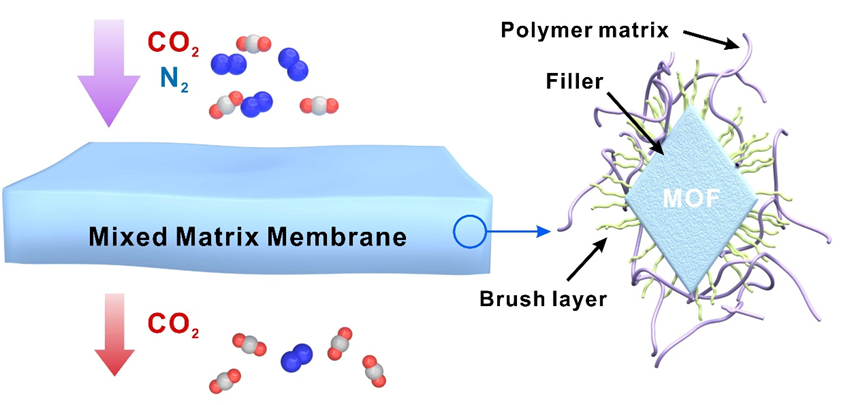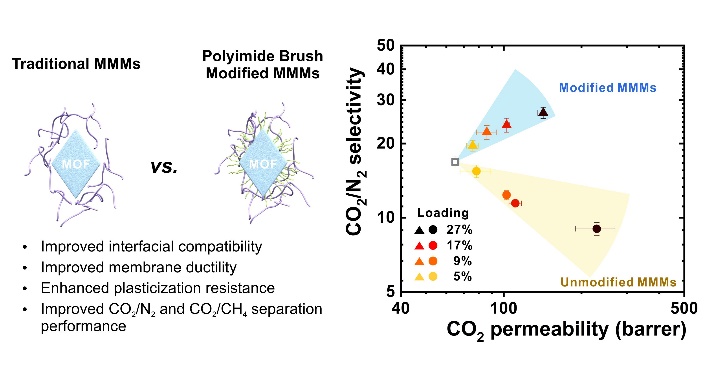The research group led by Dr. Li Tao in the School of Physical Science and Technology (SPST) at ShanghaiTech University published a groundbreaking research in gas separation membrane for CO2 capture. The work entitled “Interfacial Engineering in Metal-Organic Framework-Based Mixed Matrix Membranes Using Covalently Grafted Polyimide Brushes” is published in the world leading chemical journal “Journal of the American Chemical Society”.
Membrane technology plays a vital role in many industrial gas and liquid separation processes. For example, hydrogen recovery in ammonia manufacturing processes and CO2 removal during natural gas sweetening all rely on membrane separation technologies. Advantageously, membrane gas separation only requires a fraction of energy compared to traditional cryogenic distillation because the separation process relies on the difference in mass transport kinetics rather than phase transition. Additionally, future development of high-performance gas separation membranes could potentially solve severe environmental challenges such as carbon dioxide capture from power plant flue gases and olefin/paraffin separation etc. thereby contributing to reduced carbon emission.
Among state-of-the-art membrane materials, metal-organic framework (MOF)-based mix matrix membranes (MMMs) are regarded as one of the most promising materials for gas separation. These materials comprising MOF crystals dispersed in polymer matrices combine the highly processable nature of polymer with the size selectivity of crystalline MOF particles thereby can, in principle, significantly advance the permeability and selectivity of the membrane. Over the past decade, numerous MOF-based MMMs have been reported. The reality is that only a handful of examples reached expected gas separation performance whereas majority failed to outperformeven the polymer matrix alone. The three key reasons responsible for such non-ideal behavior are the formation of interfacial nonselective voids, pore clogging, and polymer rigidification due to poor interfacial compatibility between the dispersed phase (MOF fillers) and the continues phase (polymer matrix). Furthermore, the lack of understanding of the material interfaceand effective means to mediate the interfacial interaction in MMMs also hamper the further development of this field.
To tackle this challenge, Li group developed a covalent grafting approach to modified MOF surfaces with linear polyimide (PI) molecules thereby mediating the MOF/matrix interface. Compared to traditional MMMs that solely rely on the weak interaction between the flat surface of a MOF particle and the side chain of the matrix polymer, these covalently grafted polymer brushes can deeply penetrate the polymer matrix thereby significantly enhancing their interfacial interaction. Such interaction can be further increased by simply increasing the molecular weight of the PI brush molecules. More importantly, the chemical composition of grafted PI brushes can be kept in line with that of the matrix thereby maximizing the dispersibility of filler particles in the MMM. Experimental results indicate the PI brushes modified membranes exhibit improved ductility up to 500% and reduced interfacial tearing phenomenon under shear force.
When polymeric membranes are used for CO2 separation under high pressure, they often suffer a loss of selectivity due to enhanced polymer chain mobility induced by the dissolution of CO2. This phenomenon is known as “plasticization”. Owing to the interpenetration between the PI brushes on the MOF surface and the matrix polymer chains, the resulting membranes exhibit significantly reduced chain mobility as evidenced by dynamic mechanical analysis and rheology. As a result, these membranes exhibit significantly enhanced plasticization resistance towards CO2 thereby showing great potential for high pressure CO2 recovery. Meanwhile, the CO2/N2 and CO2/CH4 separation performance of the modified membranes exhibit simultaneous increase of selectivity and permeability, approaching the ideal MMM performance. This work paves the way to the rational design of high-performance MMMs for gas separation.
This research was conducted at ShanghaiTech University. The 2nd year Ph.D. student Wang Hongliang from Li group is the first author. Dr. Li Tao is the corresponding author. ShanghaiTech University is the first responsible institution. This work was supported by Shanghai Pujiang Program, National Natural Science Foundation of China, and the start-up funding from ShanghaiTech University.
Read more at: https://pubs.acs.org/doi/10.1021/jacs.8b10138

Figure 1. Schematic illustration of gas separation process using MMMs.

Figure 2. Left: scheme of interfacial structure for traditional and PI brush modified MMMs. Right: tendency of CO2/N2 separation performance with increasing filler loading. PI modified membrane can increase the selectivity and permeability simultaneous.


